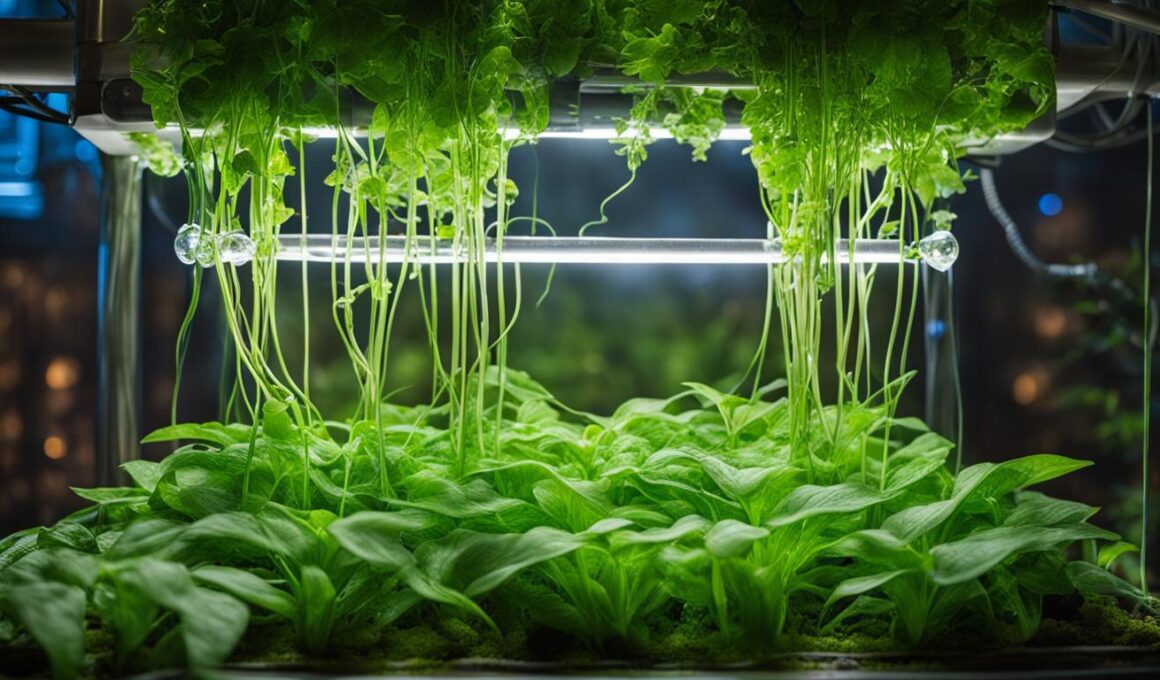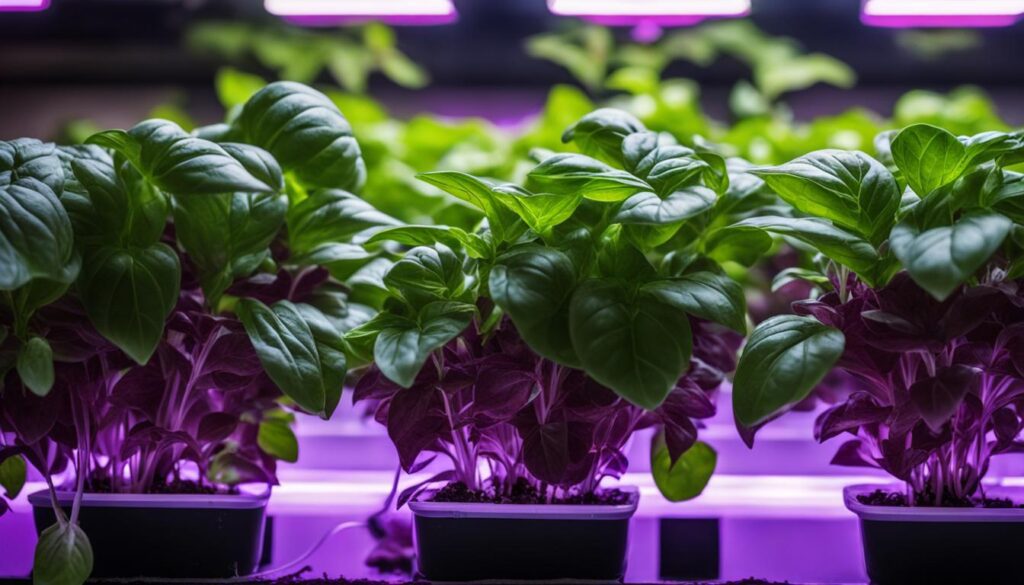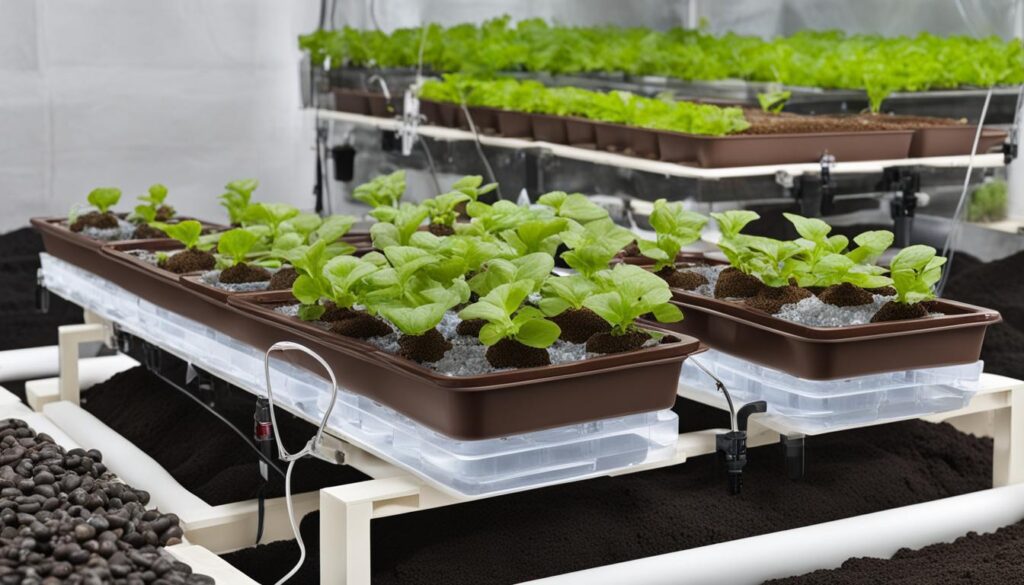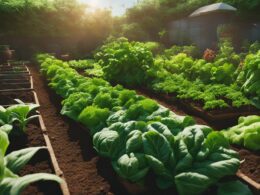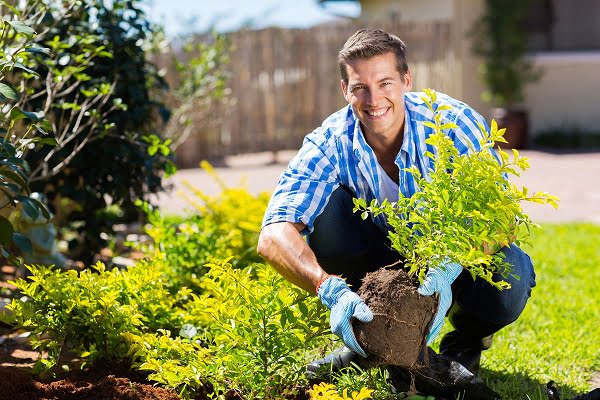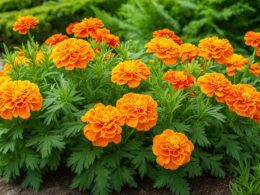Welcome to the Beginner’s Guide on how to start hydroponic plants successfully! If you’ve ever dreamed of having your own garden but lack outdoor space, hydroponic gardening is the perfect solution. This innovative method allows you to grow plants without soil, making it ideal for small indoor spaces. Whether you’re a beginner or have some gardening experience, this guide will provide you with all the necessary information to get started on your hydroponic journey.
Key Takeaways:
- Hydroponic gardening is an excellent choice for growing plants in small indoor spaces.
- It offers advantages such as increased yield, space savings, water conservation, and weed control.
- You can grow a variety of plants hydroponically, including greens, herbs, and even fruiting plants.
- The wick system is a simple and beginner-friendly hydroponic system.
- Other hydroponic systems, such as water culture, ebb and flow, and nutrient film technique, provide more advanced options.
Choosing the Right Plants for Hydroponic Gardening
When it comes to hydroponic gardening, the possibilities are endless. You can grow almost any plant hydroponically, but some are better suited for indoor gardening. Let’s explore the best plants that thrive in a hydroponic system.
If you’re a beginner, starting with leafy greens like lettuce, spinach, Swiss chard, and kale is a great choice. These crops are easy to grow and provide a consistent supply of fresh salad greens. Plus, they don’t require a lot of space, making them perfect for indoor gardens.
Herbs are another excellent option for hydroponic gardening. Basil, parsley, oregano, cilantro, and mint can be grown right in your kitchen for easy access to fresh flavors. They are low-maintenance and can add a delicious touch to your meals.
Growing Fruit-Bearing Plants
If you have more space and want to try growing fruit-bearing plants hydroponically, tomatoes, strawberries, and hot peppers are worth considering. However, it’s important to note that these plants require more care and attention, especially when it comes to providing the right conditions for fruiting. Keep in mind that fruiting plants may not produce fruit year-round, so plan accordingly.
By selecting the right plants for your hydroponic garden, you can ensure success and enjoy a bountiful harvest of fresh produce throughout the year. Experiment with different varieties and discover the joy of growing your own plants indoors.
Setting Up a Simple Wick System for Hydroponic Gardening
If you’re a beginner looking to start your hydroponic gardening journey, the wick system is an excellent option. It’s simple, easy to set up, and doesn’t require any complicated equipment or electrical components. This system is perfect for growing microgreens, herbs, and peppers. Let’s take a closer look at how to set up a wick system for hydroponic gardening.
“The wick system is the simplest hydroponic system for beginners.”
To set up your wick system, you’ll need a container for your plants, a nutrient solution, growing medium, and a wick made of cotton or nylon cord. Start by filling your container with the nutrient solution, making sure it’s enough to cover the bottom inch of the container. Place the wick into the container, ensuring that one end of the wick is submerged in the nutrient solution, while the other end is in contact with the growing medium.
The growing medium, such as vermiculite or perlite, acts as a support for the plants’ roots and allows for capillary action. This capillary action draws the nutrient solution up the wick and delivers it to the roots. It’s crucial to choose a growing medium that retains moisture well and promotes healthy root growth.
Benefits of a Wick System
- Simple hydroponic setup: The wick system is straightforward to assemble, making it ideal for beginners.
- Cost-effective: This system doesn’t require expensive equipment or complex technology.
- Low maintenance: Once set up, the wick system requires minimal monitoring and adjustment.
- Flexible placement: You can place your wick system anywhere, whether it’s indoors or outdoors, as long as there’s access to light for your plants.
- Space-saving: The compact size of the wick system allows you to grow plants in small spaces, making it perfect for apartment dwellers or those with limited gardening areas.
With a simple wick system, you can start your hydroponic gardening journey with ease. Experiment with different plants and enjoy the benefits of growing your own fresh produce at home.
Exploring Other Hydroponic Systems: Water Culture, Ebb and Flow, and Nutrient Film Technique
While the wick system is a great option for beginners, there are other hydroponic systems that offer more advanced features and benefits. Let’s take a closer look at three popular systems: water culture, ebb and flow, and nutrient film technique.
Water Culture System
The water culture system, also known as the lettuce raft system, is a simple and effective hydroponic setup. In this system, plants are placed on a floating platform, allowing their roots to be submerged in a nutrient-rich water reservoir. The constant exposure to oxygenated water promotes healthy root growth and nutrient absorption. The water culture system is particularly suitable for growing leafy greens like lettuce, as well as herbs.
Ebb and Flow System
The ebb and flow system, also called the flood and drain system, is another popular choice among hydroponic enthusiasts. This system works by periodically flooding the growing medium with a nutrient solution and then draining it back into a reservoir. This cycle ensures that the plants receive the necessary nutrients while also allowing the roots to access oxygen. The ebb and flow system is suitable for a wide range of plants, including larger fruiting plants like tomatoes and peppers.
Nutrient Film Technique System
The nutrient film technique (NFT) system is a highly efficient hydroponic system that provides a continuous flow of nutrient-rich water over the plant roots. The plants are typically placed in a sloping trough or channel, allowing a thin film of nutrient solution to flow past the roots. This method ensures a constant supply of nutrients and oxygen while minimizing water usage. The NFT system is ideal for fast-growing crops like lettuce, herbs, and strawberries.
By exploring these different hydroponic systems, you can find the one that best suits your needs and preferences. Whether you choose the simplicity of the water culture system, the versatility of the ebb and flow system, or the efficiency of the nutrient film technique, you’ll be able to enjoy the benefits of hydroponic gardening and grow your own plants year-round.
Conclusion
Hydroponic gardening is a revolutionary method that allows you to grow plants without soil. By eliminating the need for traditional gardening practices, hydroponics offers a range of benefits that make it an enticing option for both beginners and experienced gardeners.
One of the major advantages of hydroponic gardening is the increased yield it provides. With optimized nutrient delivery and controlled growing conditions, hydroponic plants can grow faster and produce higher yields compared to traditional soil-based gardening.
Space savings is another key benefit of hydroponics. With vertical gardening and compact hydroponic systems, you can grow a significant number of plants in a limited space. This makes hydroponics ideal for urban dwellers and anyone looking to maximize their growing potential.
Not only does hydroponic gardening save water, but it also allows for precise water and nutrient control. This means you can significantly reduce water usage while ensuring your plants receive the exact amount of nutrients they need to thrive. Additionally, hydroponics eliminates the need for pesticides and herbicides, providing a natural and pesticide-free growing environment.
If you’re just getting started with hydroponics, don’t be intimidated. With the right plants and a suitable hydroponic system, you can embark on a rewarding gardening journey. Start small and gradually expand your setup as you gain confidence. By following best practices and staying attentive to your plants’ needs, you’ll soon be enjoying a constant supply of fresh and nutritious produce from your own hydroponic garden.
Can the Tips for Fixing Overwatered Outdoor Plants Also Apply to Hydroponic Plants?
Yes, the easy outdoor plant fix tips can also apply to hydroponic plants. Both types of plants can suffer from overwatering, leading to root rot and other issues. Adjusting the watering schedule and improving drainage can help avoid overwatering in both outdoor and hydroponic plants.
FAQ
What are the advantages of hydroponic gardening?
Hydroponic gardening offers benefits such as increased yield, space savings, water conservation, weed control, and the ability to grow plants anywhere, including indoors.
What are the best plants for indoor hydroponic gardening?
Vegetables like lettuce, spinach, Swiss chard, and kale are easy to start with. Herbs such as basil, parsley, oregano, cilantro, and mint can be grown in your kitchen. Fruiting plants like tomatoes, strawberries, and hot peppers can also be grown if you have more space.
How does the wick system work in hydroponic gardening?
In a wick system, plants are grown in a container with a nutrient solution. A wick made of cotton or nylon cord draws the solution up to the roots. The growing medium, such as vermiculite or perlite, holds the roots and allows for capillary action.
What other hydroponic systems can I explore?
Apart from the wick system, you can consider the water culture system, which uses a floating platform for plants and a nutrient-enriched water reservoir. The ebb and flow system floods the growing medium with a nutrient solution and then drains it back into the reservoir. The nutrient film technique system continuously flows a water-nutrient solution over the plant roots.
How do I get started with hydroponic gardening?
To get started, choose the right plants for hydroponics, set up a suitable hydroponic system like the wick system, and provide proper care and maintenance for your plants. Hydroponic gardening offers numerous benefits and the opportunity to grow your own plants indoors.





